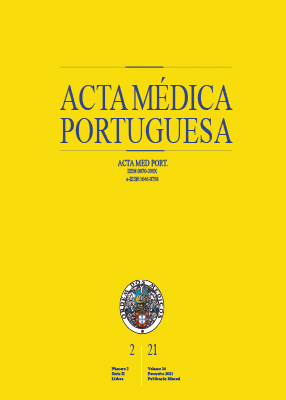Seroprevalence of SARS-CoV-2 Infection in Portugal in May-July 2020: Results of the First National Serological Survey (ISNCOVID-19)
DOI:
https://doi.org/10.20344/amp.15122Keywords:
Antibodies, Viral, COVID-19, COVID-19 Testing, Immunoglobulin G, Immunoglobulin M, Portugal, SARS-CoV-2, Seroepidemiologic StudiesAbstract
Introduction: The aim of this study was to estimate and describe the prevalence of severe acute respiratory syndrome coronavirus 2 (SARS-CoV-2) specific antibodies (immunoglobulin M and/or immunoglobulin G) in Portugal in May-July 2020.
Material and Methods: A cross-sectional seroepidemiological survey was developed after the peak of the first epidemic wave on a sample of 2301 Portuguese residents, aged 1 year or older. Survey sample was selected using a two-stage stratified non-probability sampling design (quota sampling). SARS-CoV-2 immunoglobulin M and immunoglobulin G antibodies were measured in serum samples by enzyme-linked immunosorbent assay. Seroprevalence estimates of immunoglobulin M and/or immunoglobulin G and 95% confidence intervals were stratified by sex, age group, health region and education.
Results: Overall, seroprevalence was 2.9% (95% confidence interval: 2.0% - 4.2%). Higher prevalence rates were observed in male (4.1%, 95% confidence interval: 2.6% - 6.6%) and those with secondary education (6.4%, 95% confidence interval: 3.2% - 12.5%). Differences in seroprevalence by age group and region were not statistically significant.
Discussion: The estimated seroprevalence of SARS-CoV-2 was higher than the cumulative incidence reported by the National Surveillance System but far from necessary to reach herd immunity.
Conclusion: Our results support limited extent of infection by SARS-CoV-2 in the study population possibly due to early lockdown measures implemented in Portugal and support the need to continue monitoring of SARS-CoV-2 seroprevalence in order to increase our knowledge about the evolution of the epidemic and to estimate the proportion of the susceptible population over time.
Downloads
Downloads
Published
How to Cite
Issue
Section
License
All the articles published in the AMP are open access and comply with the requirements of funding agencies or academic institutions. The AMP is governed by the terms of the Creative Commons ‘Attribution – Non-Commercial Use - (CC-BY-NC)’ license, regarding the use by third parties.
It is the author’s responsibility to obtain approval for the reproduction of figures, tables, etc. from other publications.
Upon acceptance of an article for publication, the authors will be asked to complete the ICMJE “Copyright Liability and Copyright Sharing Statement “(http://www.actamedicaportuguesa.com/info/AMP-NormasPublicacao.pdf) and the “Declaration of Potential Conflicts of Interest” (http:// www.icmje.org/conflicts-of-interest). An e-mail will be sent to the corresponding author to acknowledge receipt of the manuscript.
After publication, the authors are authorised to make their articles available in repositories of their institutions of origin, as long as they always mention where they were published and according to the Creative Commons license.









